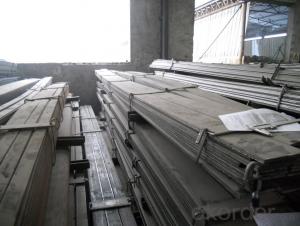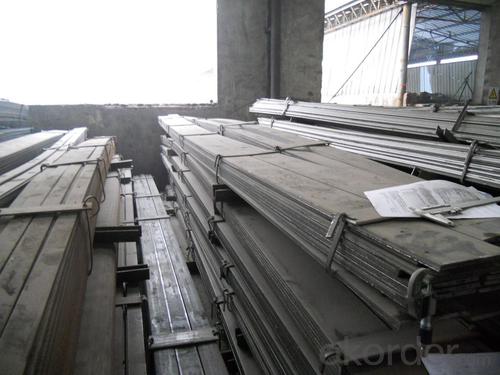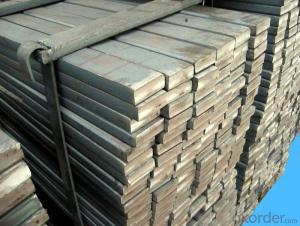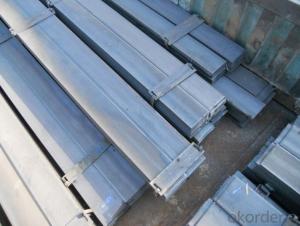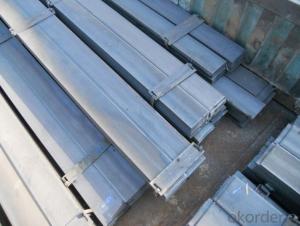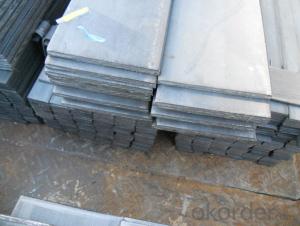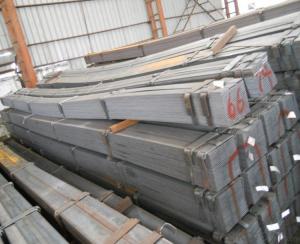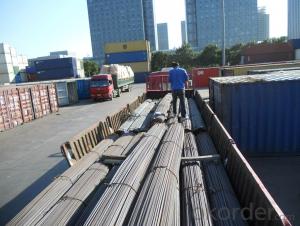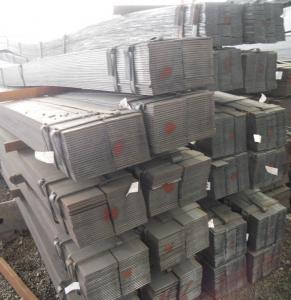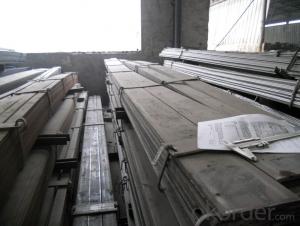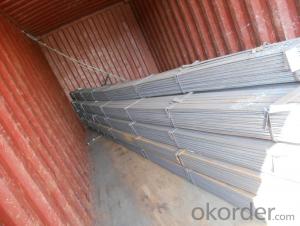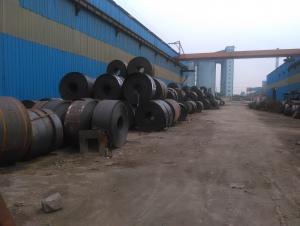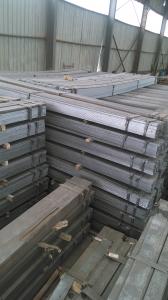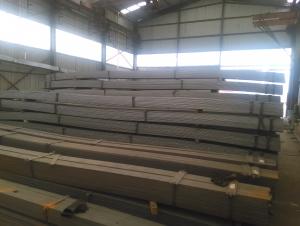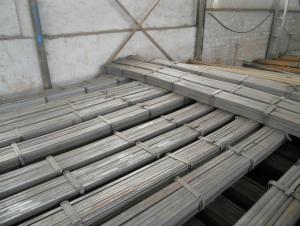Stainless Q235/275 Alloyed Mild Steel Flat Bar with High Quality
- Loading Port:
- Tianjin
- Payment Terms:
- TT OR LC
- Min Order Qty:
- 50 m.t.
- Supply Capability:
- 1000 m.t./month
OKorder Service Pledge
OKorder Financial Service
You Might Also Like
Product Description:
OKorder is offering Stainless Q235/275 Alloyed Mild Steel Flat Bar with High Quality with Leigth 6M/12M at great prices with worldwide shipping. Our supplier is a world-class manufacturer of steel, with our products utilized the world over. OKorder annually supplies products to European, North American and Asian markets. We provide quotations within 24 hours of receiving an inquiry and guarantee competitive prices.
Product Applications:
Stainless Q235/275 Alloyed Mild Steel Flat Bar with High Quality are ideal for structural applications and are widely used in the construction of buildings and bridges, and the manufacturing, petrochemical, and transportation industries.
Product Advantages:
OKorder's Stainless Q235/275 Alloyed Mild Steel Flat Bar with High Quality are durable, strong, and resist corrosion.
Main Product Features:
· Premium quality
· Prompt delivery & seaworthy packing (30 days after receiving deposit)
· Corrosion resistance
· Can be recycled and reused
· Mill test certification
· Professional Service
· Competitive pricing
Specifications of Stainless Q235/275 Alloyed Mild Steel Flat Bar with High Quality
1. Invoicing on theoretical weight or actual weight as customer request
2. Length: 6m, 12m as following table
3. Sizes:
Galvanized Flat Bar Zinc Thickness:15-80μ
Grade: A36, SS400, Q235, Q195
Standard: ASTM, JIS, GB
Thickness:1.5mm-20mm
Width: 10mm-250mm
Width | Thickness | Width | Thickness | Width | Thickness |
(mm) | (mm) | (mm) | (mm) | (mm) | (mm) |
8 | 5-7 | 50 | 5-25 | 200 | 8-40 |
10 | 3-9 | 55 | 5-25 | 220 | 8-40 |
12 | 3-9 | 60 | 5-25 | 250 | 8-40 |
13 | 5-11 | 65 | 5-25 | 260 | 8-40 |
14 | 3-12 | 70 | 5-25 | 270 | 8-40 |
15 | 5-12 | 75 | 5-25 | 280 | 8-40 |
16 | 4-14 | 80 | 6-25 | 290 | 8-40 |
18 | 4-16 | 85 | 6-25 | 300 | 8-40 |
20 | 4-18 | 90 | 6-25 | 310 | 8-40 |
22 | 4-20 | 95 | 6-25 | 320 | 8-40 |
24 | 5-20 | 100 | 6-25 | 330 | 8-40 |
25 | 4-20 | 105 | 6-25 | 340 | 8-40 |
28 | 4-20 | 110 | 6-25 | 350 | 8-40 |
30 | 4-25 | 120 | 7-25 | 360 | 8-40 |
32 | 4-25 | 125 | 7-25 | 370 | 8-40 |
35 | 4-25 | 130 | 8-25 | 380 | 8-40 |
36 | 6-25 | 140 | 8-25 | 390 | 8-40 |
38 | 7-25 | 150 | 8-25 | 400 | 8-40 |
40 | 4-25 | 160 | 8-40 | ||
45 | 4-25 | 180 | 8-40 |
5. Material Specifications:
Production Standard: GB/T 700-2006 | |||||
Grade | Chemical composition (%,max) | ||||
C | Si | Mn | P | S | |
Q195 | 0.12 | 0.30 | 0.50 | 0.035 | 0.040 |
Q235A | 0.22 | 0.35 | 1.40 | 0.045 | 0.050 |
Q235B | 0.20 | 0.35 | 1.40 | 0.045 | 0.045 |
Q235C | 0.17 | 0.35 | 1.40 | 0.040 | 0.040 |
Q235D | 0.17 | 0.35 | 1.40 | 0.035 | 0.035 |
Q235 is similar to ASTMA36,JIS SS400
Usage & Applications of Stainless Galvanized Flat Bar of High Quanlity with Leigth 6M/12M
Widely used for construction,Fabrication , Ship building, Machinery manufacturing, Steel structure
Packaging & Delivery of Stainless Q235/275 Alloyed Mild Steel Flat Bar with High Quality
1. Packing: it is nude packed in bundles by steel wire rod
2. Bundle weight: not more than 3.5MT for bulk vessel; less than 3 MT for container load
3. Marks:
Color marking: There will be color marking on both end of the bundle for the cargo delivered by bulk vessel. That makes it easily to distinguish at the destination port.
Tag mark: there will be tag mark tied up on the bundles. The information usually including supplier logo and name, product name, made inChina, shipping marks and other information request by the customer.
4. Transportation: the goods are delivered by truck from mill to loading port, the maximum quantity can be loaded is around 40MTs by each truck. If the order quantity cannot reach the full truck loaded, the transportation cost per ton will be little higher than full load.
5. Delivered by container or bulk vessel
Production flow of Stainless Q235/275 Alloyed Mild Steel Flat Bar with High Quality
The process of hot-dip galvanizing results in a metallurgical bond between zinc and steel with a series of distinct iron-zinc alloys. The resulting coated steel can be used in much the same way as uncoated.
A typical hot-dip galvanizing line operates as follows:
Steel is cleaned using a caustic solution. This removes oil/grease, dirt, and paint.
The caustic cleaning solution is rinsed off.
The steel is pickled in an acidic solution to remove mill scale.
The pickling solution is rinsed off.
A flux, often zinc ammonium chloride is applied to the steel to inhibit oxidation of the cleaned surface upon exposure to air. The flux is allowed to dry on the steel and aids in the process of the liquid zinc wetting and adhering to the steel.
The steel is dipped into the molten zinc bath and held there until the temperature of the steel equilibrates with that of the bath.
The steel is cooled in a quench tank to reduce its temperature and inhibit undesirable reactions of the newly formed coating with the atmosphere.
FAQ:
Q1: Why buy Materials & Equipment from OKorder.com?
A1: All products offered byOKorder.com are carefully selected from China's most reliable manufacturing enterprises. Through its ISO certifications, OKorder.com adheres to the highest standards and a commitment to supply chain safety and customer satisfaction.
Q2: How do we guarantee the quality of our products?
A2: We have established an advanced quality management system which conducts strict quality tests at every step, from raw materials to the final product. At the same time, we provide extensive follow-up service assurances as required.
Q3: How soon can we receive the product after purchase?
A3: Within three days of placing an order, we will begin production. The specific shipping date is dependent upon international and government factors, but is typically 7 to 10 workdays.
Q4: What makes stainless steel stainless?
A4: Stainless steel must contain at least 10.5 % chromium. It is this element that reacts with the oxygen in the air to form a complex chrome-oxide surface layer that is invisible but strong enough to prevent further oxygen from "staining" (rusting) the surface. Higher levels of chromium and the addition of other alloying elements such as nickel and molybdenum enhance this surface layer and improve the corrosion resistance of the stainless material.
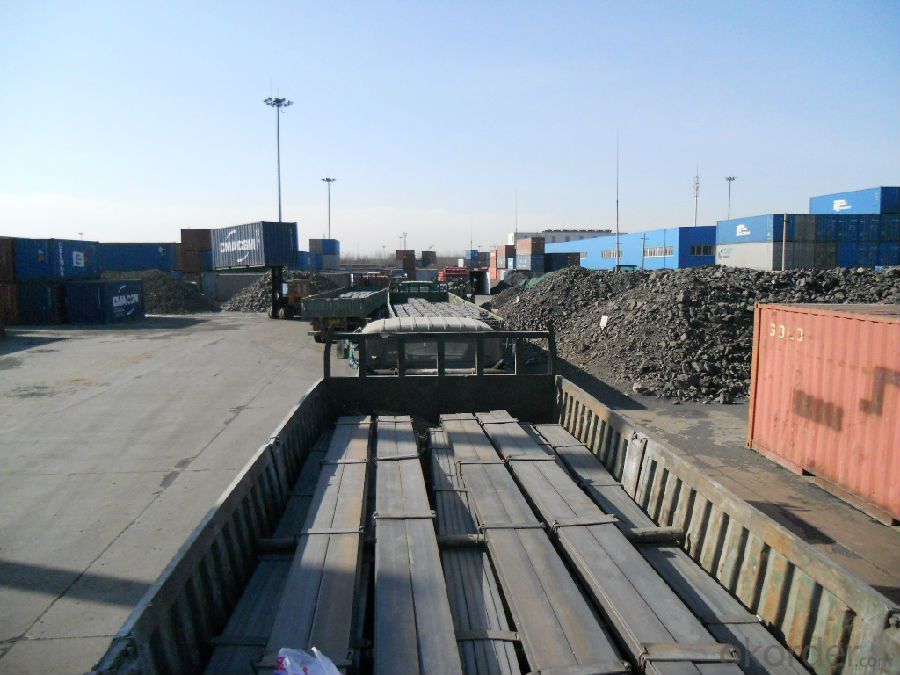
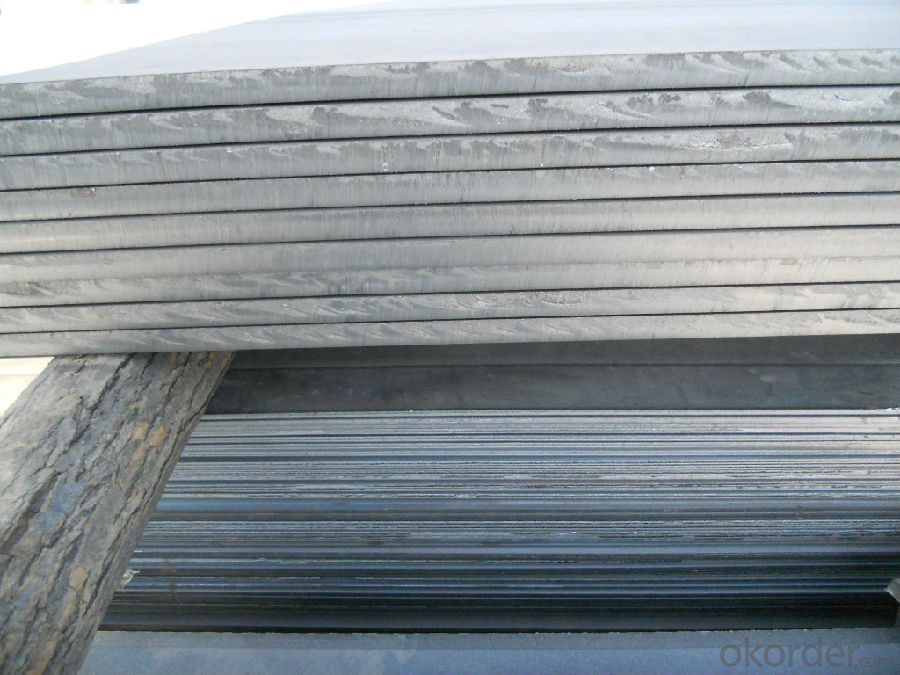
- Q: Can steel flat bars be galvanized for added protection?
- Yes, steel flat bars can be galvanized for added protection. Galvanizing is a process in which a protective zinc coating is applied to steel to prevent rust and corrosion. This process involves immersing the steel flat bars in a molten zinc bath or applying a zinc coating through a hot-dip galvanizing or electroplating method. The zinc coating provides a barrier between the steel and the corrosive elements in the environment, significantly extending the lifespan of the steel flat bars. Galvanized steel flat bars are commonly used in outdoor applications, such as construction, fencing, and infrastructure, where protection against rust and corrosion is crucial.
- Q: What are the different types of surface defects that can be found in steel flat bars?
- There are several different types of surface defects that can be found in steel flat bars. These defects can vary in severity and may affect the overall quality and performance of the steel. Some common types of surface defects include: 1. Scale: Scale refers to the thin layer of oxide that forms on the surface of steel during the hot rolling process. While it can be removed through various methods, it may still leave behind a rough or uneven surface. 2. Pitting: Pitting is characterized by small, localized depressions or craters on the surface of the steel. It can be caused by corrosion, improper storage, or manufacturing processes. 3. Scratches: Scratches are visible marks or lines on the surface of the steel, which can be caused during handling, transportation, or processing. While they may not affect the structural integrity, they can impact the aesthetic appeal of the steel. 4. Lamination: Lamination refers to the separation or splitting of steel layers along the surface. It can be caused by poor quality control during manufacturing or excessive rolling. 5. Roll marks: Roll marks are repetitive patterns or lines on the surface of the steel caused by the rolling process. These marks can affect the appearance and flatness of the steel. 6. Inclusions: Inclusions are non-metallic substances that are trapped within the steel during the manufacturing process. These include oxides, slag, or other impurities that can form visible spots or irregularities on the surface. 7. Decarburization: Decarburization occurs when the surface of the steel loses its carbon content due to exposure to high temperatures or improper heat treatment. This can result in a softer or weaker surface layer. 8. Cracks: Cracks are visible fractures or breaks in the steel surface, which can be caused by excessive stress, improper cooling, or poor manufacturing practices. These defects can significantly compromise the strength and integrity of the steel. It is important to inspect and identify these surface defects in steel flat bars to ensure that the material meets the required specifications and standards. Depending on the severity of the defect, appropriate measures such as grinding, polishing, or even rejecting the material may be necessary.
- Q: How do steel flat bars compare to other types of steel bars?
- Steel flat bars, a type of steel bar widely used and known for their versatility, possess numerous advantages when compared to other types of steel bars. To begin with, steel flat bars provide a larger surface area compared to round bars or square bars. This expansive surface area renders steel flat bars ideal for applications requiring strength and stability, such as construction or industrial projects. Moreover, the increased surface area allows for better weight and stress distribution, resulting in steel flat bars exhibiting superior resistance to bending or warping under heavy loads. Furthermore, steel flat bars are easily fabricated and shaped, making them suitable for a wide range of applications. They can be effortlessly cut, drilled, welded, or machined to meet specific project requirements. This adaptability has made steel flat bars a favored choice among manufacturers, fabricators, and DIY enthusiasts alike. Additionally, steel flat bars possess impressive strength and durability properties. Typically crafted from carbon steel, they boast high tensile strength and overall toughness. Consequently, steel flat bars can withstand heavy loads and resist deformation more effectively than other types of bars. Furthermore, they display a heightened resistance to corrosion, making them suitable for outdoor applications or environments exposed to moisture or chemicals. In terms of cost, steel flat bars generally offer a more affordable alternative to stainless steel or alloy steel bars. This cost-effectiveness renders them an attractive option for various projects, particularly in industries requiring large quantities of steel bars. In summary, steel flat bars present numerous advantages over other types of steel bars, including a larger surface area, ease of fabrication, excellent strength and durability, resistance to corrosion, and affordability. These qualities establish steel flat bars as a popular choice across a wide range of applications, from construction and manufacturing to DIY projects.
- Q: Can steel flat bars be heat treated?
- Yes, steel flat bars can be heat treated. Heat treatment is a process used to alter the physical and mechanical properties of steel by subjecting it to specific heating and cooling cycles. This process is commonly used to increase the hardness, strength, and toughness of the steel flat bars. Heat treatment can be performed through various methods such as annealing, normalizing, quenching, and tempering, depending on the desired outcome. Each method involves heating the steel to a specific temperature and then cooling it at a controlled rate. Heat treatment is commonly employed in industries such as manufacturing, construction, and automotive to enhance the performance and durability of steel flat bars.
- Q: Can steel flat bars be used for fencing or gate fabrication?
- Steel flat bars are suitable for fencing and gate fabrication purposes. Due to their durability, strength, and versatility, they are frequently employed in fencing and gate projects. By conveniently welding or bolting them together, a sturdy and secure fencing or gate structure can be created. Moreover, steel flat bars can be tailored to meet specific design criteria, rendering them a favored option for both residential and commercial fencing and gate applications.
- Q: Can steel flat bars be used for making construction equipment?
- Certainly, construction equipment can be made using steel flat bars. These bars, known for their versatility, find extensive use in the construction industry for a range of purposes, including the production of construction equipment. The exceptional strength and durability of steel make it an optimal option for building heavy-duty machinery like excavators, cranes, bulldozers, and loaders. Furthermore, steel flat bars can be effortlessly molded, welded, and fabricated into the desired shape for construction equipment. Consequently, manufacturers favor them due to their exceptional structural integrity, enabling them to endure substantial loads and withstand the demanding conditions frequently encountered at construction sites.
- Q: How are steel flat bars shipped?
- Steel flat bars are typically shipped in bundles or stacks. The bars are first stacked horizontally on top of each other, creating a bundle. These bundles are then secured with steel strapping or wire to prevent movement during transportation. Additionally, wooden or steel supports may be added between the layers to provide stability and prevent deformation. Once the bundles are prepared, they are loaded onto trucks, railcars, or shipping containers for transportation to their destination. The bars can also be shipped on pallets, with each bar individually wrapped and secured to the pallet. This method of shipping ensures that the steel flat bars arrive at their destination in good condition and ready for use.
- Q: How are steel flat bars priced?
- Steel flat bars are typically priced based on several factors including the cost of raw materials, manufacturing processes, market demand, and competition. Other factors such as size, length, quality, and any additional treatments or finishes may also influence the price. Overall, the pricing of steel flat bars is determined by a combination of these factors in the market.
- Q: What are the advantages of using steel flat bars?
- Steel flat bars have numerous benefits when used in various applications. Firstly, they possess outstanding strength and durability. Steel is renowned for its high tensile strength, making it a dependable option for structural purposes. Whether utilized in construction, manufacturing, or fabrication, steel flat bars can endure heavy loads and deliver long-lasting performance. Moreover, steel flat bars exhibit remarkable versatility. They can be easily molded, bent, or cut to meet specific project requirements. This adaptability renders steel flat bars suitable for an array of applications, including support beams, frames, braces, and brackets. Furthermore, steel flat bars showcase excellent resistance to corrosion. Through proper treatment and finishing techniques, such as galvanization or painting, steel flat bars can withstand harsh environmental conditions, including exposure to moisture, chemicals, and extreme temperatures. This corrosion resistance ensures the longevity and reliability of steel flat bars, thereby reducing maintenance and replacement costs in the long run. Additionally, steel flat bars offer cost-effectiveness. Steel is a widely accessible and affordable material, making it an economical choice for numerous industries. Furthermore, the durability and extended lifespan of steel flat bars result in reduced maintenance and replacement expenses, leading to significant cost savings over time. Lastly, steel flat bars are environmentally friendly. Steel is a highly recyclable material, enabling sustainable use and minimizing the overall ecological impact. By incorporating steel flat bars into construction and manufacturing processes, companies can contribute to a more sustainable future by reducing waste and conserving natural resources. In summary, the advantages of utilizing steel flat bars include exceptional strength, versatility, corrosion resistance, cost-effectiveness, and eco-friendliness. These characteristics establish steel flat bars as the preferred choice for a broad range of applications across various industries.
- Q: Can steel flat bars be used for making tools or machinery?
- Yes, steel flat bars can be used for making tools or machinery. Steel is a widely used material in tool and machinery manufacturing due to its high strength, durability, and versatility. Steel flat bars can be easily shaped, cut, or welded to create various tools and machine parts, making them a suitable choice for such applications.
Send your message to us
Stainless Q235/275 Alloyed Mild Steel Flat Bar with High Quality
- Loading Port:
- Tianjin
- Payment Terms:
- TT OR LC
- Min Order Qty:
- 50 m.t.
- Supply Capability:
- 1000 m.t./month
OKorder Service Pledge
OKorder Financial Service
Similar products
Hot products
Hot Searches
Related keywords
